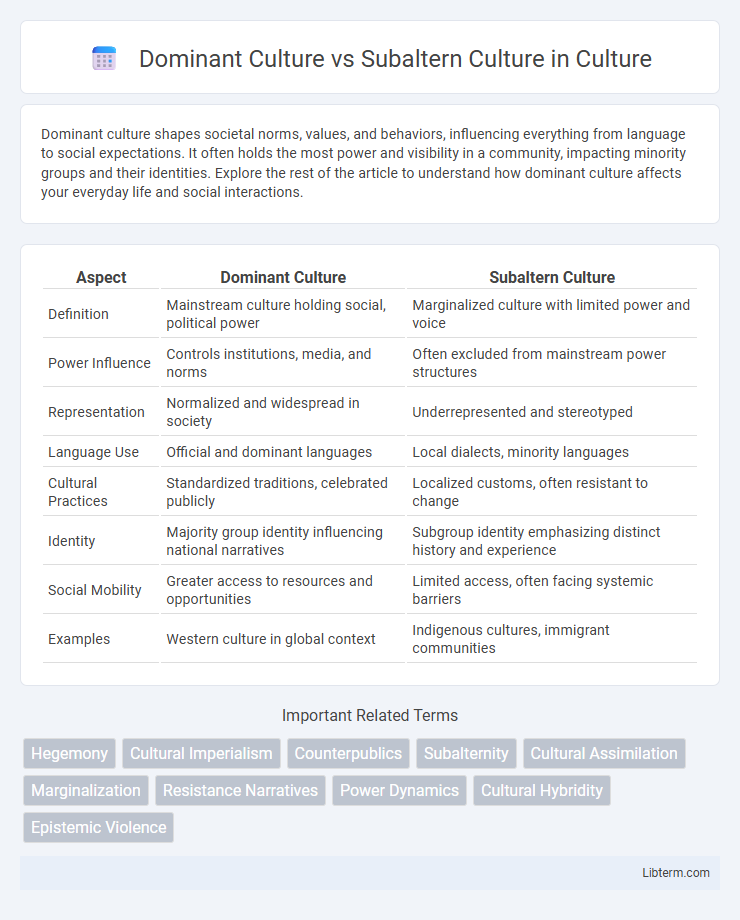Dominant culture shapes societal norms, values, and behaviors, influencing everything from language to social expectations. It often holds the most power and visibility in a community, impacting minority groups and their identities. Explore the rest of the article to understand how dominant culture affects your everyday life and social interactions.
Table of Comparison
| Aspect | Dominant Culture | Subaltern Culture |
|---|---|---|
| Definition | Mainstream culture holding social, political power | Marginalized culture with limited power and voice |
| Power Influence | Controls institutions, media, and norms | Often excluded from mainstream power structures |
| Representation | Normalized and widespread in society | Underrepresented and stereotyped |
| Language Use | Official and dominant languages | Local dialects, minority languages |
| Cultural Practices | Standardized traditions, celebrated publicly | Localized customs, often resistant to change |
| Identity | Majority group identity influencing national narratives | Subgroup identity emphasizing distinct history and experience |
| Social Mobility | Greater access to resources and opportunities | Limited access, often facing systemic barriers |
| Examples | Western culture in global context | Indigenous cultures, immigrant communities |
Understanding Dominant Culture
Dominant culture represents the prevailing values, norms, and practices upheld by the majority group in a society, often shaping social institutions, laws, and education systems. Understanding dominant culture involves analyzing how it asserts power through language, media, and ideology to maintain control and influence collective behavior. This analysis reveals the mechanisms by which dominant culture marginalizes subaltern cultures, reinforcing social hierarchies and limiting alternative worldviews.
Defining Subaltern Culture
Subaltern culture refers to the customs, beliefs, and practices of marginalized or oppressed groups that exist outside the dominant cultural framework. It often challenges mainstream narratives by highlighting alternative worldviews and social experiences suppressed by dominant power structures. This culture embodies resistance and the assertion of identity within contexts of inequality and exclusion.
Historical Context of Cultural Hierarchies
Historical context of cultural hierarchies reveals dominant cultures as those controlling political power, economic resources, and social institutions, shaping societal norms and values. Subaltern cultures often emerge from marginalized groups whose voices and traditions are suppressed or excluded in mainstream narratives. Colonial histories, racial segregation, and class stratification exemplify the systematic dominance of certain cultures over others, embedding inequality within social and cultural frameworks.
Mechanisms of Cultural Dominance
Mechanisms of cultural dominance include control over media, education, and language, which reinforce the dominant culture's norms and values while marginalizing subaltern cultures. Institutional power enforces dominant narratives by limiting access to resources and representation for subaltern groups. This systemic exclusion ensures that dominant cultural practices remain normalized and subaltern identities are devalued or erased.
Expressions of Subaltern Resistance
Expressions of subaltern resistance manifest through alternative narratives, music, and art that challenge the dominant culture's hegemonic norms and power structures. Subaltern groups employ grassroots movements, oral traditions, and symbolic protests to reclaim identity and assert agency in socio-political contexts. These acts of cultural defiance undermine dominant discourses, fostering visibility and empowerment for marginalized communities.
Representation in Media and Literature
Representation in media and literature often reflects the dominant culture's values, norms, and perspectives, marginalizing subaltern cultures by limiting their visibility and voice. Subaltern cultures use alternative narratives and aesthetics to challenge stereotypes and reclaim agency, fostering cultural diversity and critical awareness. This dynamic shapes societal understanding, influencing power relations and identity formation within multicultural contexts.
Impact on Identity and Social Structure
Dominant culture shapes societal norms and values, influencing individuals' identities through widespread media representation, education, and institutional power, often marginalizing subaltern cultures. Subaltern cultures maintain distinct identities by resisting assimilation, preserving unique languages, traditions, and social practices that challenge hegemonic narratives. This dynamic creates complex social structures where power imbalances affect access to resources, social mobility, and cultural recognition.
Power Dynamics and Cultural Hegemony
Dominant culture exercises power dynamics by shaping societal norms, values, and beliefs to maintain its hegemony, often marginalizing subaltern cultures. Subaltern cultures resist this cultural hegemony by preserving alternative narratives and practices that challenge dominant ideologies. The interplay between dominant and subaltern cultures reveals the mechanisms of control and resistance within social hierarchies.
Pathways to Cultural Inclusion
Pathways to cultural inclusion involve recognizing and valuing subaltern cultures within the dominant cultural framework by promoting dialogue, representation, and equitable access to resources. Empowering marginalized communities through education, media representation, and policy reforms helps bridge cultural divides and fosters mutual respect. Inclusive practices ensure that diverse cultural narratives contribute to a dynamic societal identity, challenging hegemonic dominance and enabling social cohesion.
Reimagining Cultural Relationships
Reimagining cultural relationships involves critically examining the power dynamics between dominant culture and subaltern culture to promote equity and mutual respect. Emphasizing interdisciplinary dialogue and inclusive narratives challenges hegemonic structures, fostering spaces where marginalized voices can redefine identity and heritage. This process encourages transformative understanding, reshaping societal norms to value diversity and cultural plurality.
Dominant Culture Infographic

 libterm.com
libterm.com